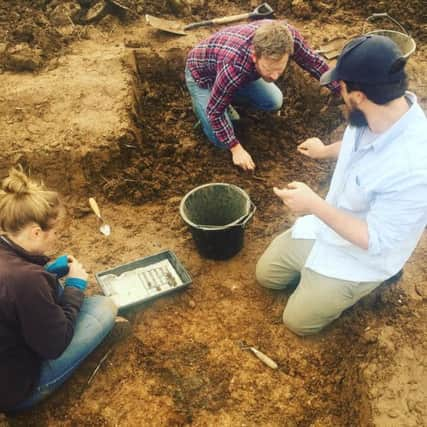'˜Once in a lifetime' discovery of Anglo-Saxon artefacts near Louth


The finds, discovered by Alan Smith, date to the seventh century, and include a gold and garnet pendant, fittings from two bronze bowls, and iron weapons, including a spearhead, two arrowheads, and fragments of a sword.
Mr Smith reported his finds to Dr Adam Daubney, finds liaison officer for Lincolnshire County Council, who said: “This is a once in a lifetime discovery. The finds are exquisite and almost certainly come from a high-status burial that was destroyed through ploughing many years ago.
Advertisement
Hide AdAdvertisement
Hide Ad“The finds date to the seventh century – a time when the elite in society were often being buried in barrows – small artificial mounds of earth. The individual would either have been placed into a grave within the mound, or perhaps even into a chamber which was then covered over.


“The artefacts discovered at this site are rare objects that clearly indicate this was the grave of someone who had an important role in society – perhaps a local ruler. This form of burial is a powerful display of status; not only was the individual being buried with a large amount of wealth, the burial mound also became a permanent feature in the landscape. This elaborate form of burial has often been seen as evidence for the emergence of kingship.”
Owing to the importance of the find, and the potential for further finds to still be below the soil, Adam got in touch with Dr Hugh Willmott, senior lecturer at the University of Sheffield, who was able to arrange for the site to be excavated. This resulted in further fragments of the bowls being recovered.
Dr Willmott said: “The finds are intriguing. While the gold pendant is an outstanding object, the real treasures are the enamelled bronze hanging bowls. The metal detectorist found two sets of ‘escutcheons’ – small, round plates that would have been attached to the side of the bowl.
Advertisement
Hide AdAdvertisement
Hide Ad“Hanging bowls are some of the finest pieces of metalwork to have been produced in the Early Medieval period. We don’t fully understand what they were used for; some may have been used in drinking rituals, but we do know from other burials that some were filled with fruit at the time of burial.”
• The finds are now being processed under the Treasure Act, and a report is being prepared for the Coroner.